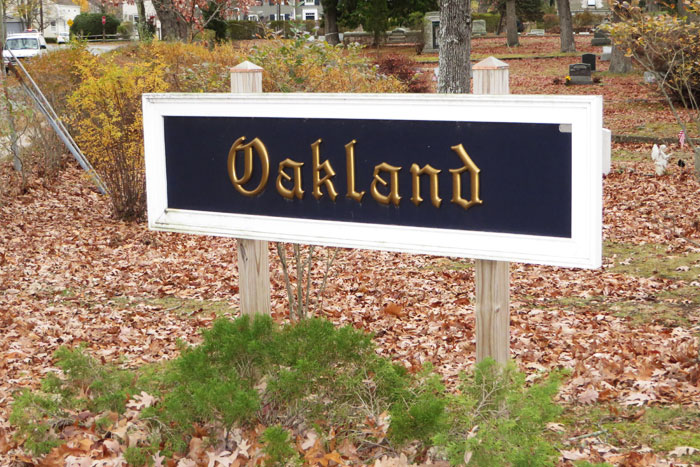Saving Oakland Cemetery from Its Namesake

Oakland Cemetery, founded in 1840, is a cornerstone of Sag Harbor’s 300-year history, yet it has fallen into disrepair. Many of its oak trees are dead or dying, the namesakes threatening to crush the grave markers below. If something wasn’t done, the damage would soon be irreparable.
“The people of Sag Harbor are all represented in Oakland, past present and future,” says Sag Harbor resident and landscape architect Edmund Hollander. “I was walking through one day with some other people from the village, and I saw how it wasn’t being cared for… I reached out to tree companies, professional advisors, the mayor, and the response has been enormous.”
Thanks to Hollander’s outreach, and the full support of Mayor Sandra Schroeder, dozens of local businesses and organizations, including 17 landscape and tree-removal companies, will work together to remove dead and dangerous trees and branches in what they are calling the “Oaks for Oakland” project.

Photo credit: Courtesy Ellen Rubin
“We’ve done a lot of work in the cemetery to see which trees are salvageable, which can be saved and which are to be removed,” Hollander says. “There are probably about 200–250 trees in the cemetery, and this is really the first step in a multiyear program to preserve what we have. One of the reasons it’s so time consuming and expensive is…. You can’t just cut a branch; you’ve got to tie them off, secure them.” The gravestones of Oakland Cemetery both complicate and inspire the work Hollander hopes to achieve.
Some of the stones offer a glimpse into the village’s rich and diverse past. In the 19th century, Sag Harbor rivaled New York Harbor in its number of whaling vessels. There are more 18th and 19th century sea captains buried in this Sag Harbor cemetery than in any other location on Long Island. It is the final resting place of celebrated authors and dancers. It contains the ancestors of many old Sag Harbor families, including a member of one of the oldest Sag Harbor families, Queen Olive L. Pharaoh, of the Montaukett Indian tribe. The cemetery is nondenominational, and provides a complete picture of life in Sag Harbor 200 years ago.
Hollander says that once the importance of restoring the cemetery was realized, the community’s answer was massive. “Each landscaping and tree company is donating probably $5,000 worth of work. The response was both immediate and positive. Some companies I didn’t reach out to called me up and asked to be involved. Even the local pizza places, everyone with the ability to help has stepped up to the plate to do it… I think there is a great wealth of community spirit, among companies here to not only do good work for clients but also do good work for the community; I was really overwhelmed by the response to this….The community spirit and the desire to be involved are tremendous.”
The businesses will rally on December 7 and 8 for the major tree-removal job. The many professional volunteers will carefully remove the dangerous trees and branches from the site, while providing the proper protection to the grave markers. “It’s basically the arboreal equivalent of D-day,” Hollander says. On December 8, the wood will be hauled away and offered to any resident who wants it. Some of it is also being chipped for mulch. In the spring of 2017, new oaks will be planted on the grounds. The care paid to the Oakland landscape in the upcoming months will help preserve the site for years to come.
“There’s so much emphasis on maintaining the architecture of the village, but there hasn’t been as much emphasis on the landscape…. Oakland is this jewel at the center of Sag Harbor. I think we have to value the public spaces within the village here. The Architectural Review Board takes care of the village buildings, but the landscapes are so important to the character of the area….We want to make sure that Oakland is as great for the future as it has been for the past generations.”
Contributions to the Oaks for Oakland effort are welcome. Send to Sag Harbor Tree Fund, P.O. Box 3133, Sag Harbor, NY 11963.



